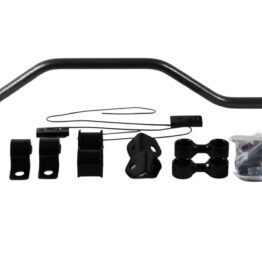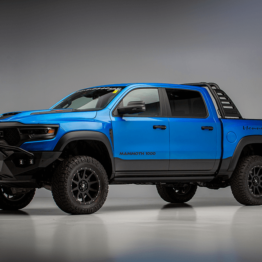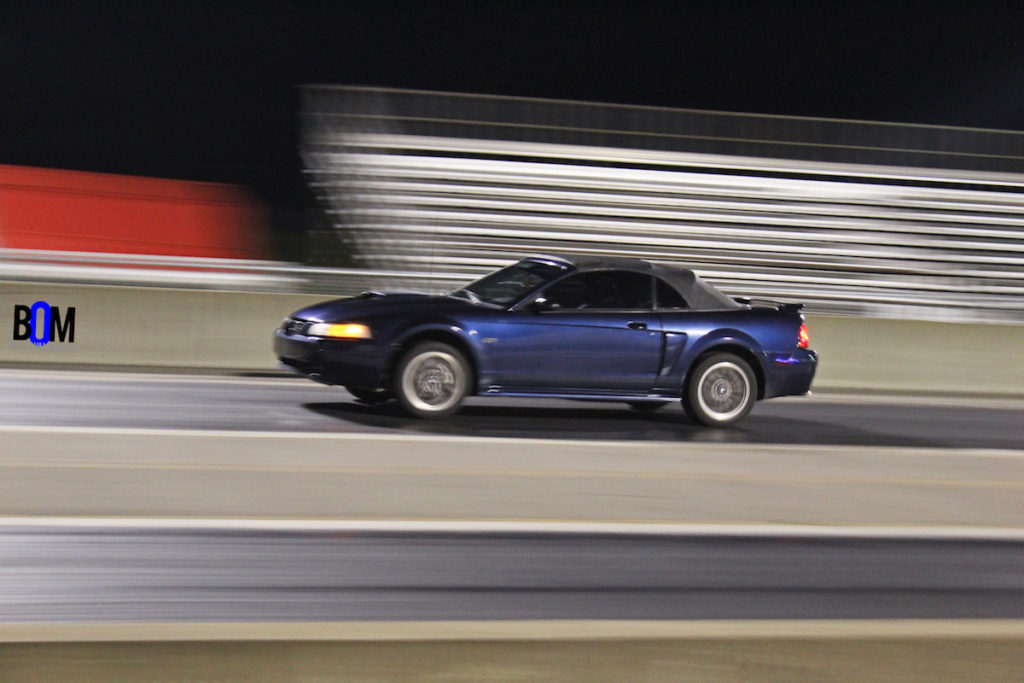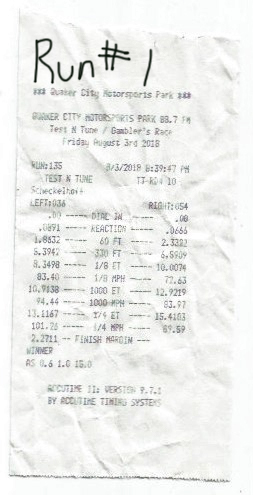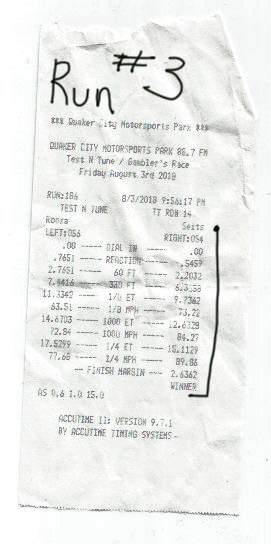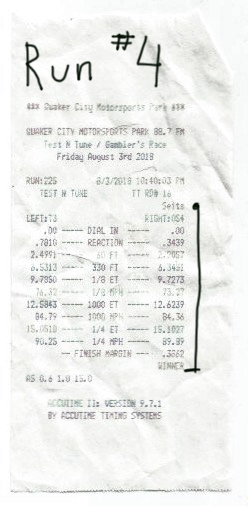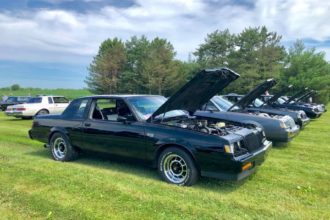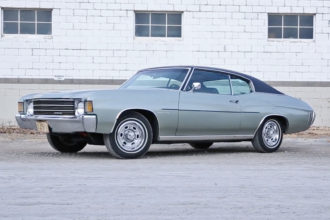Photos by: the author and Taylor Seitz
Still Not 100%, We Put True Blue to the Test, Anyway
Over the Summer, we’ve kept you updated on Project True Blue, with a brake upgrade, a tune up and a few articles currently still in the “pending” phase of the process — it’s going to be a long-term deal for sure! Despite the car’s shortcomings, we felt that it has long since been time to hit the track to see where this car stood from a performance standpoint.
Like we’ve established in the introduction article, we knew what to expect from a stock PI 2V car if everything was in good knick. However, our automatic 2001 Mustang GT has since clocked in 142k miles and nearly 18 years worth of wear and tear. We know the whole car isn’t 100%; with tired, worn out stock suspension, worn out off-brand tires and the transmission and rear diff more than likely overdue for a fluids change.
The good news is, we’ll know where our weak points are at after our baseline testing is complete. It should also reveal any and all problems laying within the car that hasn’t made itself known before. With 3,000 miles of drive time behind us on this car since its introduction, it was time to see what she could deliver.
Baseline Dyno Testing
Going into this, we weren’t looking for earth-shattering numbers, but we had a general idea what to expect. Back in the days when these cars were shiny, new and the latest thing going from Ford, some of our colleagues found elsewhere in the magazine world have done much of that testing for us, to at least give an idea of what our benchmark should be.
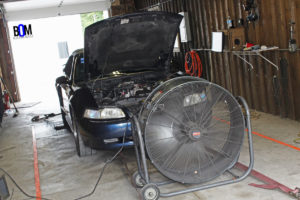 Rated at 260hp and 302 lb-ft of torque at the flywheel from Ford, we certainly want every horsepower we can extract from the stock engine. From our experience, these cars hover between 230 to 235 horsepower to the tires, bone stock, and that’s on a Dynojet chassis dyno.
Rated at 260hp and 302 lb-ft of torque at the flywheel from Ford, we certainly want every horsepower we can extract from the stock engine. From our experience, these cars hover between 230 to 235 horsepower to the tires, bone stock, and that’s on a Dynojet chassis dyno.
On a Mustang dynameter, you can expect 5-10% less, putting it in the range of 207 and 223 horsepower, so that’s the expectation we have.
For testing, we recruited our friends over at FJ Performance in Export, Pennsylvania. They’re a fully-equipped tuning shop that generally specializes in late-model GM LS-series hardware, but have been known to dabble with modern Fords, Mazdas and other makes from time to time, with excellent results.
Naturally, simply baseline dyno-testing this 2V GT would be a walk in the park for them, and with their in-ground Dynojet ready to rock, we were optimistic.
FJ Performance is about a 110 minute drive from our AutoCentric Media offices, and we strapped the car down fresh off of the highway haul. Being eager, we only gave it a 10-12 minute cool down before we fired up the rollers. In a perfect world, we would have let dirt cool down for 45 minutes or so, but we were strapped for time that day.
Then, reality hit with a loud clang.
Nothing broke, seized or exploded, but the numbers we saw on the dyno graph were a little disheartening. The car also experienced a light glitch with the electrical system at WOT and in the higher RPM range. There was something of a miss, despite the recent tuneup; which included fresh plugs and a fuel filter, air filter, Royal Purple fuel injector cleaner and a cleaning of the MAF sensor and throttle body.
The car didn’t display any check engine lights, other than the flicker of the battery light under WOT, like we’ve just mentioned. After a few pulls, however, the light stopped flickering and the miss seemed to clear up. What we ended up with was a peak output of 211.47 horsepower and 247.29 lb-ft of torque to the rear tires.
If you’re just tuning into the project, we should again remind you that up to this point, the car was completely bone stock — even down to the exhaust, mufflers and stock paper air filter. Stock tuning, as well. Also, it’s an automatic, which would typically rate lower than your average 5-speed example. Using some simple math, our 211 rwhp translates to either 262 hp or 266 hp to the flywheel, depending on where you turn for insight.
As far as that battery light flicker is concerned?
It never did it on the way home from FJ, despite our best efforts. We had the alternator tested after we got back into town, and it tested fine. We did notice that the battery was a little wobbly, and it turned out to be a cracked battery tray. We promptly replaced it with an OEM replacement one from Tasca Parts.
The price for a new tray from them, shipped, was actually lower than what a local yard wanted for a used one. Also, the negative battery cable connection had some corrosion going on with it, so we cleaned that and rewrapped it with fresh electrical tape. So far, no more miss.
Hitting the Dragstrip
One of the good things about being locate in Northeast Ohio, is the amount of local drag strips that are available. You have Thompson Raceway Park, Summit Motorsports Park, Dragway 42, National Trail Raceway and Quaker City Motorsports Park, which is in our neck of the woods, among others.
With a tight schedule and other projects vying for our time, we elected to hit up Quaker City, as it was only about 30 minutes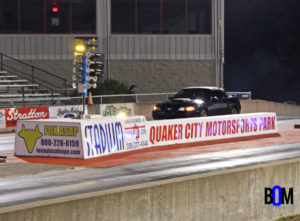 from our AutoCentric Media offices. We also chose this particular track, because it’s the same track where your author had tested a previously-owned 2000 GT convertible, also automatic, back in the day when it was new.
from our AutoCentric Media offices. We also chose this particular track, because it’s the same track where your author had tested a previously-owned 2000 GT convertible, also automatic, back in the day when it was new.
Although that car was modified with a Steeda G-Trac suspension, Flowmaster exhaust and a K&N drop-in style air filter, with no other changes the car would click off E.T.s in the 14.4-14.5 bracket all day long. We never did strap that one down to the dyno, however.
Knowing the minimal amount of additional horsepower and torque the air filter and exhaust would’ve added, we were hoping for only slightly slower times from True Blue.
Well, those “low” horsepower numbers reared their ugly head again.
Getting right in line with next to no time for a cool down, the car clicked off a 15.4 — ouch! After the first run, the staging lanes were clear enough that we were able to make an immediate follow-up pass — with the same time. OK, so let’s give it time to cool the car down…
After sitting in the shade with the hood open for about 45 minutes, it was time to hit the track again. Our third pass only gave us an extra tenth. Something was seriously wrong, but where? Again, there’s no way a catback and air filter would give one of these cars a second in the quarter-mile, and knowing how completely stock examples in this car’s configuration would run back in the day, we couldn’t let these terrible numbers slide.
We dropped the tire pressure down to 18-psi. in the rear, made sure the front tires were pumped up to max capacity, left the car in Drive/3rd, and launched it in a high enough RPM to the tires would reach their breaking point. It was so hot and humid that day, though, that icing down the intake was almost imperative. After an hour-long cool down we were rewarded with a 15.11, followed by a 15.10 twenty minutes later.
After that point, the street car lanes were closed and it was time to hit the road. Feeling both disappointed and determined to get this 2V turd in the 12s, at least, we came to the realization that our work was cut out for us.
Conclusion
Well, I’m not blown away by how this car performed at the dragstrip or on the dyno — it’s basically on par with a very well-running, 225hp 1998 version of itself. We need to dig deeper into what’s slowing this car down.
In the coming weeks, we’ll take a closer look at the MAF, IAC and TPS sensors, possibly replace the EGR, do a proper fuel injector cleaning, courtesy of our friends over at Injector Experts, and check out the condition of the original catalytic converters. I have a feeling that after 142,000 miles, they’re either failing or getting clogged. While we’re at it, maybe replace the O2 sensors as well.
We’ll have to do all of these things around the same time our JLT cold-air kit and Borla catback exhaust goes on. We’ll also perform a differential and transmission fluid replacement, with some Royal Purple synthetics. With a little tweaking, we should be able to get the car back to where it should have been to begin with, add additional power, and install upgraded rolling stock and updated suspension.
We can only go up from here!

Rick Seitz is the owner and founder of AutoCentric Media, and has a true love and passion for all vehicles; GM, Ford, Dodge, imports, trucks — you name it! When he isn’t clacking away on his keyboard, he’s building, tuning, driving or testing his current crop of personal projects!




